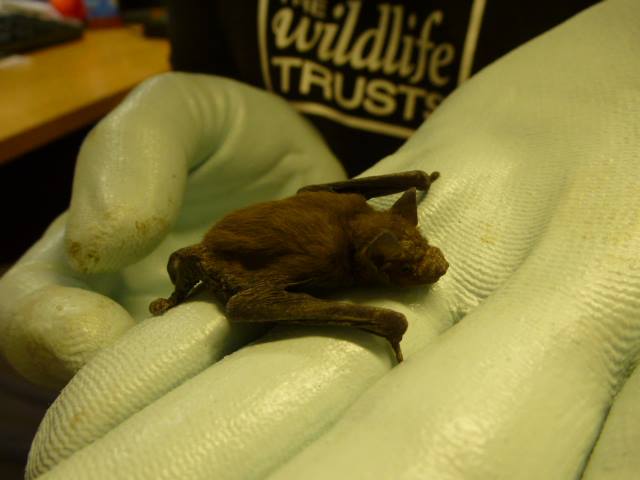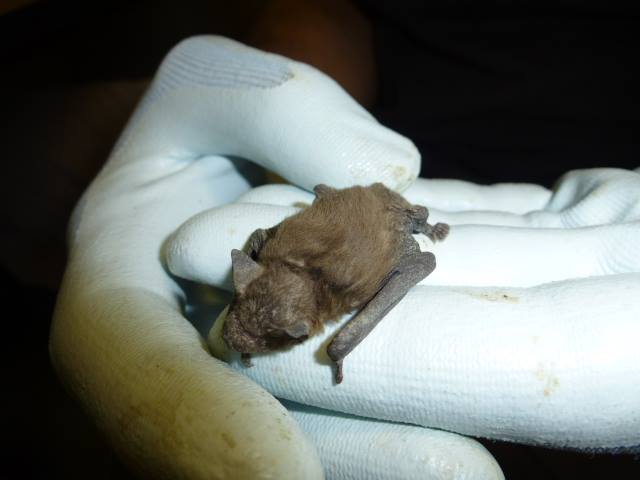Now is a peak time for finding grounded bats.Aidan has been finding these and much more over the last couple of of days
I received a call from Simon about a Bat Care call near my home in Biggleswade. A lady in Broom had found a pup (baby bat at 5pm on Friday the 5th just outside the backdoor. She’d spoken to BCT and they advised her to place it in a tub with some kitchen paper and a small container of water, which she had done. She left the bat out overnight in the hope that it would crawl away, but it was still there the next morning, when she contacted Simon – Beds Bat Care Co-ordinator. By the time I got to the house, it had unfortunately expired from dehydration and hunger. Pups require regular milk feeds and the mothers often return to a maternity roost to suckle during the night and continue this throughout the day, after the night hunting foray is done. The temperature on the Friday and Saturday had been in the high twenties and stayed quite warm overnight, even with the water available this bat had just not had enough coming in to keep it going for two full days and a night.
I had a look around the back of the house and found a few droppings on windowsills and the floor. I then moved around the side of the house and found a lot more droppings and these were also on the wall, windows and Soffit boxes at the apex. ‘Hmmm… Looks like that’s where they may have been coming from.’ I think. ‘Have you seen bats around the house?’ I say. ‘Oh there was one in the house a few years ago, but we think that had come in through the patio doors in the evening, as it was found in the morning on the curtain.’ ‘And what about outside around the house?’ I say. ‘Sometimes in the garden around dusk, but not many.’ ‘Well, judging by the droppings, it’s likely that you have a maternity roost in the end of the house, are you happy for me to come back later to see if any bats come out.’ This was then agreed and I returned at 21.20 and set up a chair to view that side of the house.
I could hear the bats chattering to each other, jostling to be the first to leave. They would be drained of all milk and very hungry, ready to get out and go hunting. The first bat emerged at 21.35 and was followed by a steady stream of bats for about 40 seconds, then nothing except chattering for a few minutes. Out popped another few that circled round for a moment and encouraged some more to leave the roost. I was sitting watching the bats counting using a thumb tally to record the figure, and listening on the bat detector to hear the start of the calls as each bat emerged. This helps you keep track of them if you happen to look away to take a swig of coffee the home owner has just brought you. ‘Have you seen many?’ she asks. ‘Err… a few, 63 so far.’ She stayed chatting with me for a few minutes and then went back inside, complaining of a pain in the neck. I think that this was because of looking up at the roof and not as a reference to me or the bats. Roost emergence counts are best done from a chair that allows you to rest your head, as they often take over an hour and this causes a most uncomfortable cramp.
The bats kept popping out and there were plenty of fly-bys by bats that had already emerged, almost calling those left to exit out to play and feed. Every so often, one would almost land on the wall, only to turn away again. Close attention had to be kept at this point as a re-entry to the roost would lead to confusion as the next bat emerges. ‘Was that the bat that went back in coming out again or one that was already in emerging for the first time?’ is the question that goes through your head. If this happens it’s time to finish the count and record the results. I had tried not to count in my head or look at the thumb tally display apart from to answer the homeowners question earlier, so had no idea of whereabouts the total had got to.
The first bat that actually landed and re-entered the roost was at 22.12, so I then stopped counting the emergence and just watched the twenty or so bats that were circling around the garden and roof top. The total tally at the time of this re-entry was 150 Soprano pipistrelle +/- a few, which accounts for the dropping evidence scattered all along the passageway. I brought the homeowner up to speed on the roost and gave them some general advice – ‘Ignore it, unless it’s and major problem, in which case contact the BCT helpline, who can give you all the advice you want or they’ll organise a Roost Visitor to come and see you, might possibly be me anyway.’ I say, and then gave floor and wall a quick scan again before I left.
This is when I found a corpse of a pup that could have only been a few days old when it died and a live pup sitting on the wall a few feet off the ground. This was again very de-hydrated and thin and this also died very soon after it was found, before I managed to get it home to feed up on goats milk. I have since had another call from this house and collected another bat, which 36hrs into my care is still alive, but seems to have a major infestation of mites and lice, another good reason to wear gloves when handling bats. I spotted another pup just outside the roost entrance as I picked this bat up and am expecting the phone to ring any minute with a call to come and collect another pup.
Ideally these need to be re-united with the mum in the roost as soon as possible, but the access to do this at this roost is very difficult, basically a very tall ladder would have to stand in the neighbours garden, straddle over the fence and then still not be tall enough to allow me to gently persuade the pup to re-enter the roost. The other option is to place the bat on the wall as close as possible to the roost, and allow the pup to crawl towards the chattering of the yet to emerge bats and hopefully rejoin mum. This doesn’t always happen as mum may have moved out of the roost already, have died before the pup left the roost or to have rejected the pup having figured out that it is possibly physically damaged and wanted to conserve her own energy by not trying to bring up a bat that wouldn’t be capable of fending for itself if it was weaned. Hopefully this little chap will hang in there until I can get him back to the roost and then meet up with his mum, a small chance of success but worth a try.
This is the second roost Aidan has found in the past week. The other one only had 150 bats in
Very young pups have a limited chance of survival because they dehydrate so fast, If you find one, give BCT’s National Helpline a call and they will pass on details to us. Because almost all of the bat carers are working full time, it is usually not possible to make an immediate response but we do our best.
National Bat Helpline 08545 1399 228


